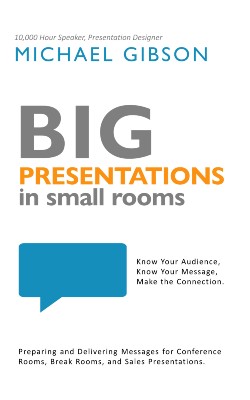Presentation microphones are uncommon in small room presentations. In your experience, they might be rare. But occasionally, you will encounter something different.
Do not stress. You got this!
You have a goal. You organized your content and practiced the delivery. And now it is time to share your message!
When someone at the presentation site approaches you and asks,
“Do you need a microphone?”
You do not panic or automatically decline. You think about the contents of this article.
When needed, the presentation microphone usage should be guided by these three tips. Protect energy. Ensure access. Know preference.
Presentation Microphone Tip 1: Protect Energy.
Most small room presentations do not require microphones, but some will. For example, I once taught a series of classes to a group of 20 people. We met in a banquet room that could seat 500 people.
Another time I taught a class for 16 people in a full-sized gymnasium. Even though the participants were sitting nearby, the sound would get lost in the room. A presentation microphone was required.
Microphones can kill the energy of your presentation. This fact is counterintuitive because you might feel that the microphone makes you sound cool. You can drop the volume and slip into Jazz DJ mode or maybe channel your inner Barry White. You don’t have to use your diaphragm to push the sound out because the mic will do the work for you. Don’t stumble into this natural pitfall. Do the work and own the energy.
Some settings call for a low pitch, calming vibe. But this is not true in most places where microphones are used. If you slip into the trap of low energy communication, do not be surprised when the audience begins to slip away.
I have public-speaking friends who have great voices—soft, warm, and comforting. But if they stay in that range for too long, I will drift off into a nice cozy nap!
Discover the appropriate energy level for your presentation and protect that energy. Do not let the presentation microphone take it from you. This responsibility might require you to work with the person in charge of sound (or find the volume controls). It might require you to hold the microphone further from your mouth or step back from the mic stand.

Presentation Microphone Tip 2: Ensure Access.
I was hosting a series of meetings in south Texas. It was a small group, perhaps 12 people. There was a microphone set up next to the podium. A couple of times, someone dropped a hint that I should use it. I declined. I have a big voice. I don’t need a microphone. The audience was attentive and polite, and I thought things were going well.
Thankfully, one of them was willing to pull me aside during a break and let me know that a few participants had hearing impairments. Uh-Oh! There was a good reason for the presentation microphone being there. I needed to use it.
48 million people in the U.S. have trouble hearing with one (or both) of their ears (NIH). That is about 15% of the population.
The second tip is to ensure access. Suppose you are in a setting that does not seem to need a microphone, and you are offered one. Take it. Use it. Assume that there is a reason for the offering.
Hearing loss is not always visible. Hearing aids are getting smaller, and some people refuse to use them. You cannot look around and know whether people present are hard of hearing. The offer (or presence) of a microphone is a clue that it is needed. Ensure access for every person present.

Presentation Microphone Tip 3: Know Your Preference.
The third tip is to know your preference.
“Do you want a handheld, a lapel mic, or a headset? If you want a handheld, do you want a mic stand?”
It is a common question for big presentation in big rooms. And it is an occasional question for big presentations in small rooms. When you have an option, please make the most of it! Choose what works best for you. Here are some things to keep in mind.
I have been speaking in front of various size groups for over 25 years. And it is not uncommon for my hands to be shaky for the first few minutes of a presentation. It is a common occurrence among public speakers all over the work.
So, if your hands tend to shake, do not stress about it (that would make it worse!). Simply avoid holding a mic during that time. If a handheld is your only option, try to secure a mic stand and use it until you are past the nervousness.
If you are distracted by having a headset, avoid using it. If your hair, glasses, or outfit makes it awkward or uncomfortable, choose a different option.
If you are wearing clothing that is not conducive to a lapel mic, do not take that option. It is distracting when a mic clip slips. The mic creates noise as it hits your clothing. And then you must fix it! Recovering and replacing the mic causes a distraction from your message.

The Bottom Line about Presentation Microphones
The bottom line is this. Know the situation. Acknowledge the possibilities (there might be people present who are hard of hearing). Discover the best options. Choose the best one. And confidently present your message.
Want to know more? Keep reading.
Want to know even more? Order the book, Big Presentations in Small Rooms.
Do you have any stories involving presentation microphones?
Do you have any tips to share?




